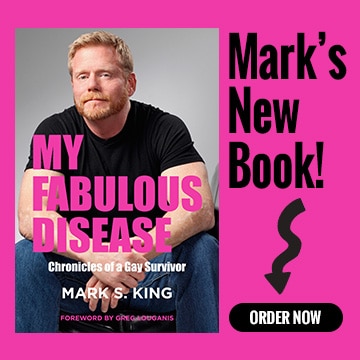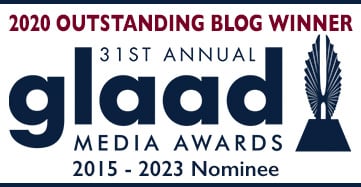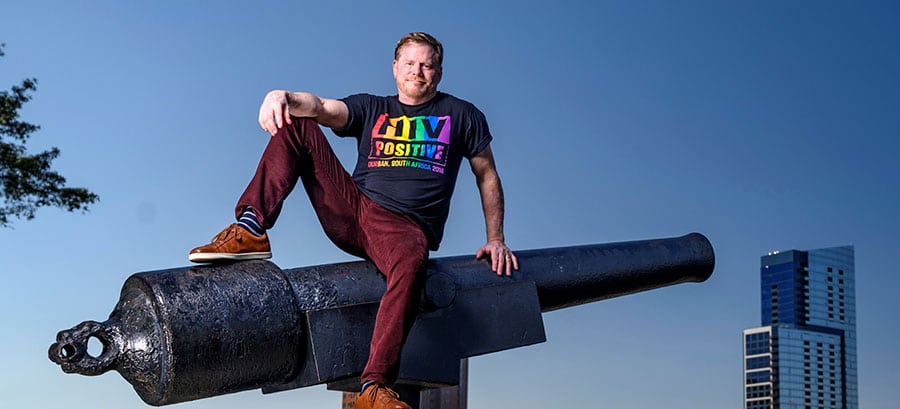(This essay, which originally appeared in the April/May issue of Poz Magazine, ignited conversations about “unexpected” AIDS deaths among those in our circle of friends. It is also the basis for a workshop at the upcoming United States Conference on AIDS (USCA) entitled “Are We Shaming Those Who Are Detectable?” The workshop will take place at USCA on Saturday, September 8, from 2-4pm.)
A friend of mine, Antron-Reshaud Olukayode, died of an AIDS-related illness a few months ago. He was an Atlanta-based writer and HIV advocate. The news was quite a shock for me because an empowered person living with HIV isn’t supposed to die at age 33. Or so I believed.
During Antron’s last hospital stay, his friend Nina Martinez brought him food and comfort. “Antron was having trouble getting on his feet. Something was hurting,” she tells me during a conversation in which she doubted her choice to be open about the details, to tell the truth of it. “And then Antron pulled down his sock and showed me a black lesion on the bottom of his foot.”
Nina immediately recognized the spot as Kaposi’s sarcoma, known as KS, an often deadly AIDS-defining cancer. You can regularly see it on the faces and bodies of people with AIDS in old photos and documentaries. People think it doesn’t happen anymore. They’re wrong.
Nina herself is HIV positive. She contracted the virus through a blood transfusion when she was a few weeks old. She knows all too well the cunning ways that HIV can damage a body. Because people on effective treatment don’t just end up with late-stage complications, she realized that Antron had not been taking his medications, probably for a long time. Looking at Antron’s foot, Nina asked him whether the spot was KS.
“Antron looked at me and said yes,” Nina recalls, with the exhaustion of fresh grief in her voice, “and then there was this release, like a pressure cooker, and he started to cry. Antron was afraid of being judged. I wasn’t going to judge him, but he knew his community would.”Antron had been a visible HIV advocate and volunteer, even appearing in a national media campaign by the Centers for Disease Control and Prevention as someone living with HIV.
But somewhere along his journey, things changed. He seemed depressed. Medications stopped. Very few of his friends understood what was happening, much less what to do about it. Antron was an AIDS death hiding in plain sight.
A few days after his conversation with Nina, Antron lost his ability to speak. His family took him home to die in the town he had once escaped. His obituary did not mention AIDS.
Antron became one of the nearly 7,000 HIV-positive people who die of causes directly attributable to the virus every year in the United States. It’s a stunning number to reconcile in this day and age, and its effects multiply many times over when you include the grieving families and confused friends and frustrated clinicians. Each one of those 7,000 people represents a life that wasn’t supposed to end, at least not to incredulous onlookers who don’t understand how or why anyone with HIV could die anymore.
It’s a fair question, the why of it. Why would anyone never get an HIV test, ignore symptoms, stop their medications or hide their illness? Who exactly are these 7,000 people? What the hell happened?
In search of answers, I talked to workers on the front lines, in clinics and hospitals and community agencies. I talked to patients and activists and people in waiting rooms. Most of them were eager to share what they have seen. Very few wanted to be identified. The truth can be uncomfortable.
What I discovered is that when you ask why, there are so many, so terribly many, answers to the question.
In the first decades of AIDS, testing HIV positive meant joining a community in which you were embraced by an enormous support network. We had no choice but to be open about our HIV status because our very lives were at stake. Long-term survivors and community elders passed along shared history and survival skills.
Not anymore. People who test positive for the virus today often face the health care labyrinth alone. Some prefer it that way because they have a good doctor and pharmacy benefits and their status is none of your business. They are entitled, yes, indeed, to their privacy and to their limited interaction with what passes for an HIV community these days by showing up once a year for a walkathon that has stripped AIDS from its name and replaced the disfigured gay men in wheelchairs with baby strollers and French bulldogs and chicken on a stick.
Welcome to the public face of HIV in 2018. It is a parade, and it is warranted because there is so much to celebrate, after all. The parade has billboards at busy intersections and posts on Instagram. It has the pretty faces of empowered HIV-negative people taking pre-exposure prophylaxis, or PrEP, and people living with HIV taking pride in their undetectable viral load.
There are T-shirts and ball caps and posters. There are online memes and funny web videos and signs you hold up when you smile for the camera and blogs with names like — God, help me — My Fabulous Disease.
It is a parade we have all helped to create. It is a privileged affair, with few people talking about the homelessness and poverty and drug addiction that percolate upward from the forlorn and the forgotten. Meanwhile, HIV stigma keeps spreading over the spectacle like a rolling fog.
The 7,000 people who will die this year can’t hear the happy jamboree from the lonely confines of their apartment or hospital bed or shelter or prison cell. If they could, they might think we have all lost our fucking minds.
***
Campaigns that seek to normalize people living with HIV are missing an important truth, according to long-term survivor and activist Matt Ebert. “U=U feels like a lie,” he tells me, referring to the award-winning “Undetectable Equals Untransmittable” campaign heralding the fact that people with an undetectable viral load cannot transmit HIV. Matt believes the science of it, but the word standing in the middle of the catchphrase makes him cringe.
“I am not equal to someone who is negative,” Matt contends, “not in the way I am treated and not in the way I feel. These campaigns try to promote our sameness, but testing HIV positive is the same shot to the heart it has always been.”
“If I got HIV today, I would be devastated,” Matt explains. “It’s a very big deal. HIV affects every decision I make. People say I should be grateful to be alive. Well, it doesn’t work that way. No wonder people stop taking their meds.”
“And,” Matt adds pointedly, he feels this way despite being “white and privileged.”
Activist Kairo Brown, who founded the organization Meet for a Cause to help impoverished LGBTQ youth in Baltimore, doesn’t have time for endless discussions of privilege or racism, as bad as it may be, because he is consumed by the daily struggle for survival among those he serves. “I hear us blame white people,” Kairo says, “but what about what we as Black people are doing to other Black people? We must unite as a community.”
There is meager social support within the Black community for people living with HIV, Kairo believes. Many young Black men are trying to deal with their own feelings of brokenness, with their search for a crowd that will welcome them, even if for some it means never returning for treatment after testing positive because the price of transparency in their circle of friends is much too high. As in every other community, women are often left to fend almost entirely for themselves.
Community workers across the spectrum told me about impoverished clients who fill out clinic surveys in exchange for financial incentives, checking any box at all, signing anything handed to them, because they need a free bus pass a lot more than they care about the data making sense. They know people who allow themselves to become sick, treating HIV symptoms with an Advil from the gas station, because they believe illness will get them more services.
Case managers told me about clients who tested positive and then scoured the internet, searching for another answer that might explain things away, falling victim to fake potions and frauds, because a bullshit answer is better than the one that says HIV.
HIV providers talk of clients who store their medications under bushes because the shelter doesn’t have lockers. They watch the treatment regimens of their patients start and stop at roughly the same rate as their monthly hospitalizations, when drugs are dripped from IV bags in a mad scramble to repair the damage. They draw blood from people addicted to opioids using the arm that hasn’t been amputated because of an infected abscess.
And all the people living with HIV in the margins of our society, advocates and sex workers and mothers and addicts and case managers alike, know they are one disconnected cell phone, one bout of depression, one missed bus, one part-time paycheck away from total devastation.
There are even revelers in the grand parade who are privately troubled, who grit their teeth when they smile, who haven’t admitted that it has been months since they took their meds because the co-pay got too expensive or the fatigue of it all has become too much to bear, who have chosen to delay treatment until things get bad or until they find a cheaper apartment or until some unseen solution comes along. It might. It might not.
***
These AIDS-related complications are real, and they exist in a world far away from happy Facebook status updates. Traveling the distance between them might as well be crossing the galaxy.
And yet, mercifully, even in the midst of all these challenges, success stories and moments of grace exist.
Brent Bible took an HIV test when he was 17 years old as a requirement to enter a teen drug rehab program. “They called me and said to come back in and bring my mom,” Brent tells me. “When they said I was positive, my mom broke down. But I was like, Everything is OK. I’m not going to cry about it.”
Sometimes, youthful resilience is nothing of the kind. The next day, Brent tried to kill himself.
“It didn’t work,” Brent says. “So, I just said, Fuck it, I’ll party.” He escaped his troubles—the absent dad and the addicted mother and the challenges of being a gay Black man—by defiantly choosing hard drugs over HIV medications. He remembers that time with tears in his eyes. “It was hard, for so many years,” Brent tells me. He’s 29 years old now, but some things still haunt him.
Brent eventually pulled himself from the brink, but getting HIV care required a stability he hadn’t yet achieved. “I didn’t have a place to stay,” he tells me, “and I needed proof of where I lived, proof of this and proof of that. And I wasn’t working and didn’t have transportation. Some places were no help at all.” Today, Brent makes his doctor appointments and takes his meds, and his viral load is undetectable. He knows he is lucky. He knows people who were broken by the pressure of life with HIV.
“Being around them, they seemed happy,” Brent recalls, remembering several friends in their 20s who are now lost to AIDS, “but behind closed doors, they might just be done with it all. You just don’t know. You never really know.”
We have a collective responsibility to Brent, to help him rise above the stigma, to continue his treatment in the months and years ahead, to ask him uncomfortable questions when he says he is just fine, to teach him survival skills and to assure him that everyone living with HIV doesn’t always feel as happy as they look on the posters.
Because the statistic that 7,000 people will die simply waits, year after year, to be satisfied. Because depression and fatigue can undermine the will to live. Because people deserve the truth about life with HIV and the support to face it. Because we don’t want to be shocked all over again and left wondering why.
Because you never really know.
Mark






